The hardest part of any fishing trip is finding fish in the first place. Use this seven-step process to find speckled trout in Louisiana, every time you launch the boat.
More...
90% Of The Battle Is Finding Fish To Catch
The hardest part of any fishing trip is finding fish in the first place.
Everything else, whether it is changing lure colors, high performance reels or fancy trolling motors, is all useless if you're not "on the fish".
So what can you do? Well, keep reading.
How The Pros Find Speckled Trout In Louisiana
It's safe to assume every professional angler out there has his/her own way of locating whatever inshore species completely from scratch, but I am willing to bet they all look something like this seven-step process:
Let's go over these one by one:
Step 1: Identify Your Target Species
You can't find what you want if you don't know what to look for.
It's very important to decide what fish you want to catch (whether it's speckled trout, redfish, flounder, black drum, sheepshead or whatever) and then stick with it.
Focusing on one species is the equivalent of keeping your eye on the ball in a baseball game.
This is key because all the aforementioned species are unique, spawning, feeding and behaving differently.
Because of this, there are different ways to catch each, so it's best to focus on one, and the most popular is speckled trout followed closely by redfish.
Rolling to "Plan Redfish"
A good example of species-specific fish behavior affecting your planning would be that of sexual maturity and legal length in speckled trout versus redfish.
Speckled trout are sexually mature by nine or ten inches in length, so those fish are long gone from the marsh during their summertime spawn.
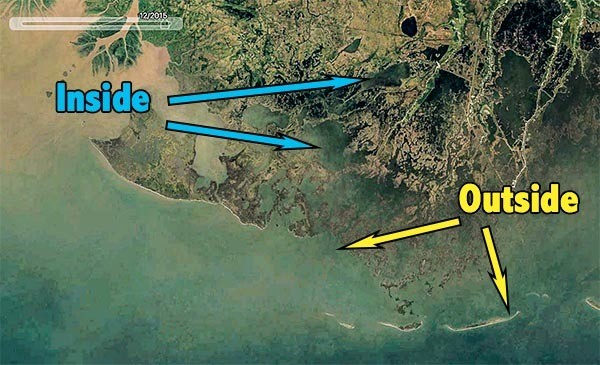
Speckled trout are found "inside" during the winter and "outside" during the summer.
However, redfish are different in that they do not reach sexual maturity until the upper end of their slot length at 27 inches.
So, redfish under 27 inches in length are in fact juveniles and are found in the marsh year round.
When the going gets tough for speckled trout, "Plan Redfish" is there to save the day.
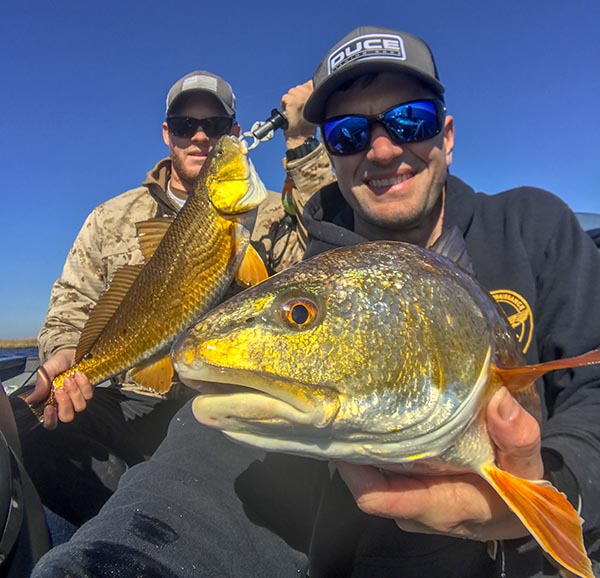
Step 2: Identify The Seasonal Pattern
Seasonal patterns dictate when, where and how you will catch speckled trout.
When To Launch The Boat
During the summer fish tend to bite best during the morning when it's still cool, and in the winter they tend to bite later in the day after the sun has had time to warm them up.
Where To Go Fishing
Time of year plays a huge role in fish location.
For example, speckled trout are nowhere to be found inland during July, because they're all on the "outside" spawning in saltier waters.
However, the opposite is true in January, when we find them much closer to the dock in less saline waters.
What Fish Are Eating
Season also dictates the primary forage fish are feeding on!
A good example would be the white shrimp migration during the fall, and violet gobies during the winter.
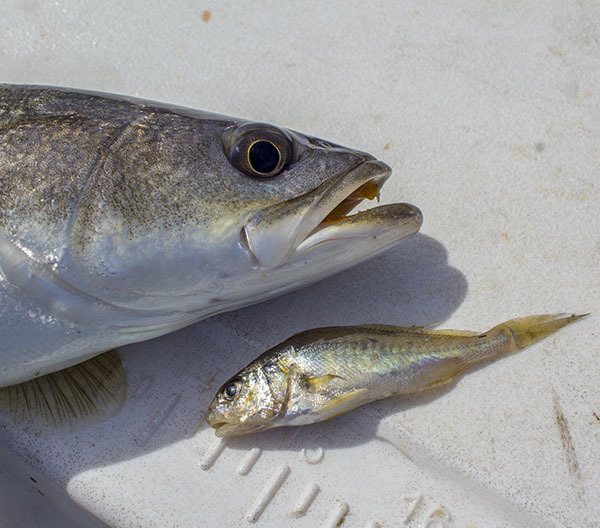
You will know where to find speckled trout in Louisiana if you have a good idea as to what they are feeding on.
Step 3: Look At The Wind Forecast
Arguably the most important condition to look at, wind strength and direction will determine the following things:
- where you can (and cannot) go fishing
- how easy it will be to cast
- which bodies of water are navigable
- water clarity
- best fishing technique
- where to launch the boat
- when and how much the tide will move
If you've attended Mastering The Tide, then you already know that tide tables are pretty much garbage and what really matters is accounting for all the conditions affecting water levels.
It's a really good seminar, and highly recommended to inshore anglers wanting to find speckled trout in Louisiana.
Anyway, as far as resources go, Windfinder is my favorite app for wind predictions.
Step 4: Gauge Water Levels
It's very important to know not just the tide, but how the wind will affect the tide and where the tide is beginning from on the day of your fishing trip.
Pro Tip: The tide almost never begins where you think or does what it is predicted to do.
The wind and gravitational forces from the sun and moon will work together to create water movement that looks different from what is actually predicted, and those who are good at finding speckled trout in Louisiana are ready to capitalize on this.
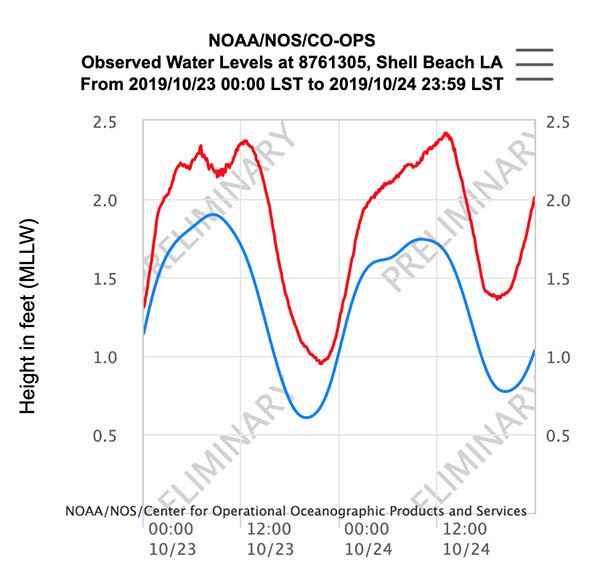
This graph clearly depicts that what is predicted is not always what happens.
Best case scenario: the wind chills out, conditions are stable and the tide does what is predicted.
Worst case scenario: you get a false neap tide, also known as a "liar tide".
Again, Windfinder is preferred for tidal predictions and NOAA's National Data Buoy Center is great for looking up past and current water levels.
Step 5: Judge The Light Conditions
This one is easy: sunny days are better for sight fishing redfish, and overcast weather is better for speckled trout.
In fact, all of my best days of speckled trout fishing have happened in overcast weather.
Windfinder also forecasts this.
Step 6: The Impact of River Water
I'm including this because it's easy and something I definitely look for when targeting speckled trout, because they are so sensitive to it.
Speckled trout don't like dirty river water, and will move out when it approaches, like what happened during the Bonnet Carré Spillway opening.
Areas completely inundated in river water are immediately omitted from any fishing plans, with redfish sometimes being an exception.
I like to use MODIS Satellite Imagery to see where river water is, as well as Hydrocoast's salinity maps.
Step 7: Check Fishing Reports
Last but not least, it's good to read the latest fishing reports to get an idea where fish are biting.
However, like anything, there are pros and cons to weigh.
For example, if you are reading lots and lots and lots of fishing reports for one particular area, chances are it's blown out, the fish are pressured (read: not biting anymore) and there's absolutely no point at all in going there.
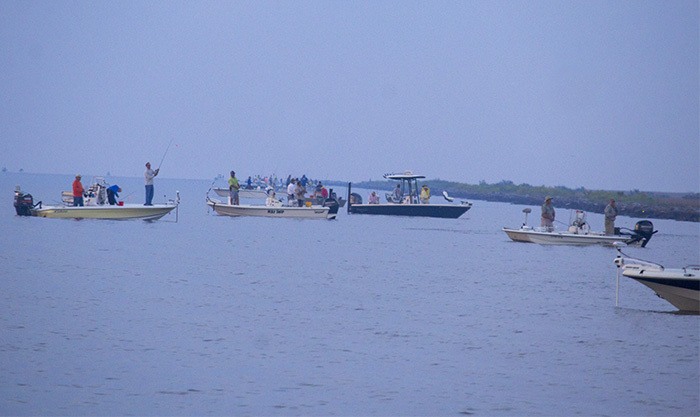
Unless you enjoy this sort of thing, there really is no point in fishing because of all the pressure.
Yep, usually by the time you hear about it the bite is on it's way out, or just gone.
But, if there are only a couple fishing reports for an area, especially if it's not a "community honey hole", then there's most likely plenty of real estate for a great fishing trip to happen.
Also, it's good to look up local guides and see how they're doing. Facebook is great for this!
I'll Show You How I Find Speckled Trout In Louisiana
These seven steps are what I use on every fishing trip to decide which area is best to go fishing.
Obviously there's more to it and the relevant details can be found in the blog posts linked up throughout this one (you're welcome).
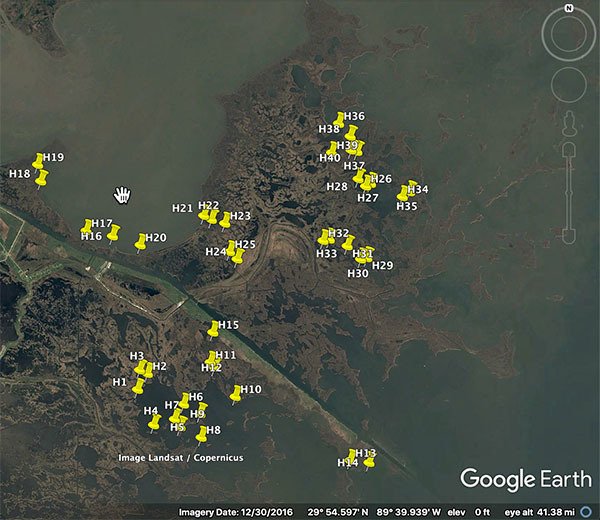
Join me in a planning video as I pick out fishing spots for my next fishing trip, all based on the six steps outlined in this blog post.
But, that doesn't change the fact that, if you're new to inshore fishing (or don't find biting fish on every trip), the planning process can be a little daunting.
This is why I teach the process to find and catch fish from scratch inside Inshore Fishing 101. There you will learn how it is I find and catch fish in every kind of condition there is:
- rising and falling tides
- 30mph winds
- cloudy days
- heavily pressured areas
- completely brand new areas
- freezing temperatures
- hot summer days
- and more!

Thanks, Mike! Feel free to subscribe here: https://www.lafishblog.com/subscribe/
Great article. I have been following your blog thru social media for years and most recently on your website. Plenty of great content for anglers of all experience levels. Keep up the good work! Mike
Hey Gary, thanks for asking.
Yes, I have fished out that way but don’t regularly. Honestly, it’s a tough place to fish because it’s inundated by river water, especially with river levels in recent years.
Unless the river gets low, you’re better off trailering somewhere else.
As always, thanks for commenting and being such a long time follower.
great read, thanks. it spells out many things I do subconsciously but helps me to build a checklist.
thanks
do you give reports from Cypremort Point, vermilion bay, Marsh Island
You’re welcome. I appreciate you taking the time to watch, Gary.
As always good info Devin even though these are thing’s I have always known but not always used haha. I do subconsciously think about all seven I need to put them to practice. Thanks for the free video and info for all to see and use if there smart !
You’re welcome. Thanks for commenting.
Thanks for the post